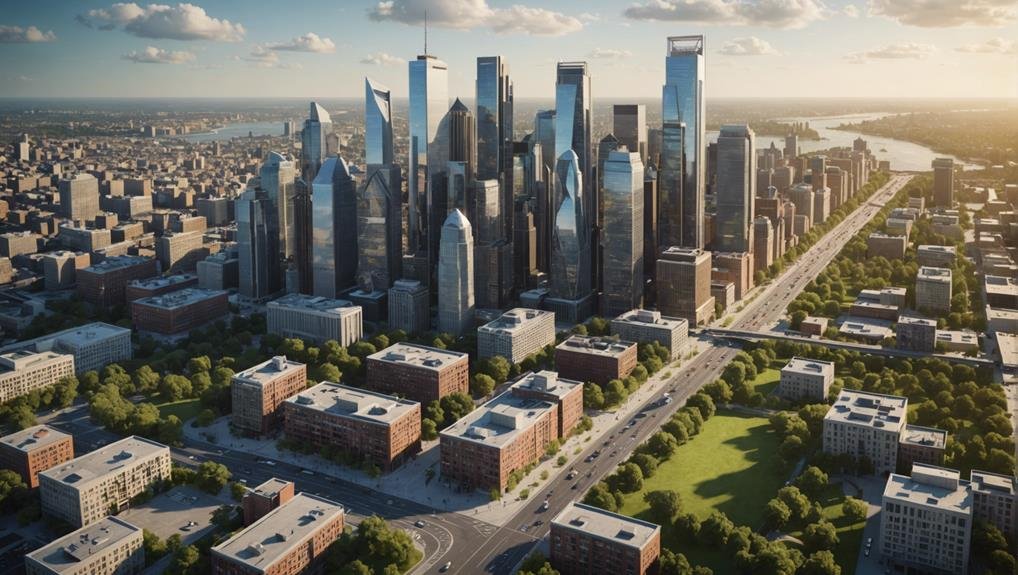City Planning: Unlocking Urban Development Potential
City planning is pivotal for harnessing urban development potential by addressing challenges like population growth and infrastructure demands. Zoning regulations play a vital role in guiding growth, ensuring order, and protecting resources. Efficient land use optimization, coupled with sustainable urban planning strategies, fosters resilience and minimizes environmental impact. Embracing smart growth principles and prioritizing mixed land use can enhance quality of life and spur economic development. Understanding the role of city planning opens the door to a future where cities thrive sustainably and communities flourish.
Key Takeaways
- Implement smart growth principles to combat urban sprawl.
- Focus on sustainable, compact, and efficient planning strategies.
- Promote mixed land use and prioritize public transportation.
- Enhance residents' quality of life through urban development.
- Drive economic growth and ensure social equity in city planning.
Urban Development Challenges and Opportunities
Amidst the evolving urban landscape, the intricate interplay between urban development challenges and opportunities presents a dynamic canvas for innovative solutions and sustainable growth.
With rapid population growth placing strains on existing infrastructure, cities are compelled to undertake significant infrastructure upgrades to meet the needs of their expanding populations. The need for modernized transportation systems, efficient waste management solutions, and upgraded utilities is paramount to support the increasing urban populace.
Balancing the demands of a growing population with the necessity for sustainable development practices requires strategic planning and visionary leadership. Effective management of infrastructure upgrades in response to population growth is essential for fostering resilient and thriving urban environments that can adapt to the challenges of the future.
Role of Zoning Regulations in Development
In understanding the urban development landscape, grasping the intricate role of zoning regulations is pivotal for shaping sustainable growth and fostering resilient urban environments.
Zoning regulations play a critical role in guiding urban growth by stipulating how land can be used and developed within a city or municipality. These regulations help maintain order, prevent overcrowding, and promote safety within urban areas.
By designating specific zones for residential, commercial, industrial, or mixed-use purposes, zoning regulations guarantee that development aligns with the overall vision for the city. Additionally, they help manage infrastructure demands, protect natural resources, and maintain the quality of life for residents.
Maximizing Land Use Efficiency
Efficient land use optimization is a cornerstone of sustainable urban development strategies aimed at maximizing resources and minimizing environmental impact. Land utilization plays a pivotal role in ensuring that urban spaces are utilized effectively to support growing populations and economic activities.
Building optimization further enhances land use efficiency by maximizing the functionality and capacity of structures within a given area. Through strategic planning and design, cities can increase the density of development while maintaining quality living standards and preserving green spaces.
Sustainable Urban Planning Strategies
Maximizing land use efficiency through sustainable urban planning strategies involves meticulously integrating environmental considerations, economic imperatives, and social equity goals into the fabric of city development.
Green infrastructure plays a pivotal role in sustainable urban planning by promoting eco-friendly solutions such as green roofs, permeable pavements, and urban forests. These initiatives not only enhance the aesthetic appeal of cities but also mitigate the urban heat island effect and improve air quality.
Additionally, transportation solutions like promoting walkability, developing bike lanes, and investing in public transit systems are essential components of sustainable urban planning. By prioritizing pedestrian and cycling infrastructure alongside efficient public transportation networks, cities can reduce traffic congestion, decrease carbon emissions, and enhance overall livability for residents.
Future Trends in City Development
What innovative strategies are shaping the future landscape of urban development?
The future trends in city development are increasingly focused on smart growth to combat the challenges posed by urban sprawl. Smart growth principles emphasize sustainable, compact, and efficient urban planning that promotes mixed land use, public transportation, and environmentally friendly practices.
By prioritizing smart growth initiatives, cities can create vibrant, interconnected communities that reduce reliance on cars, preserve green spaces, and enhance overall quality of life for residents. This approach not only addresses issues of congestion and pollution but also fosters economic development and social equity.
Embracing smart growth strategies is vital for steering urban development towards a more sustainable and resilient future.
Conclusion
In the intricate tapestry of urban development, city planning serves as the master weaver, crafting a vision of sustainable growth and functionality.
Through strategic assessments and regulatory frameworks, city planners reveal the potential of urban landscapes, sculpting a landscape that harmonizes with nature and cultural heritage.
Like a skilled artist painting on a canvas, city planning shapes the vibrant mosaic of cities, blending efficiency, sustainability, and innovation into a masterpiece of urban evolution.







